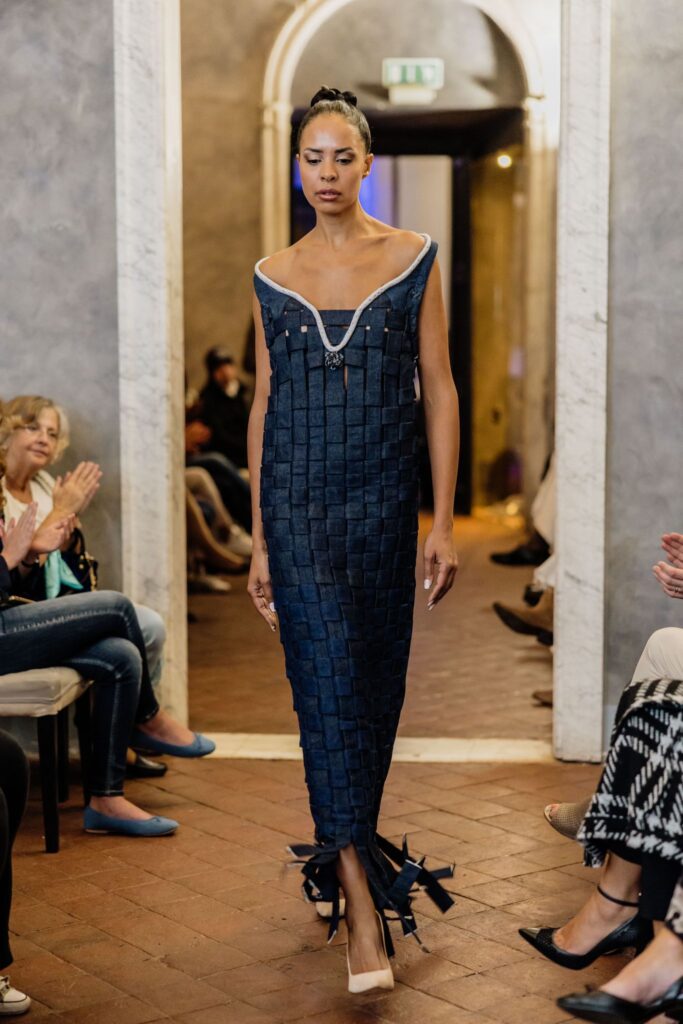The 3rd edition of the Dione Fashion Show closed with a spectacular finale titled “Genoa Fashion Week,” curated by Senegalese-Italian designer Kiné Dione. The event showcased a multicultural blend of fashion, highlighting the elegance of African creations alongside global styles, setting a unique stage for the confluence of cultures through fashion.

Dione Fashion Show, Italy 2024
Mrs. Dione’s latest collection was inspired by her discovery of the origins of denim fabric, tracing its roots back to Genoa, Italy. “I was invited by the Liguria craft federation in Italy for their ‘Jean’ Fashion Week, where I learned that the fabric known as ‘Jeans’ likely originated in the city of Genoa in the 15th century,” Mrs. Dione explained to The Nile Tribunes. “Back then shipbuilders and merchants in Genoa used a coarse, sturdy cotton known as ‘Bleu de Gênes’ for sails and to protect goods. When this fabric made its way to America, it became known as ‘Blue Jeans,’ celebrated for its durability and affordability,” she added.

Dione Fashion Show, Italy 2024
The history of denim in North America is marked by the involvement of a Swiss banker, Jean Gabriel Eynard, and his brother Jacques, who traveled to Genoa in the 1800s. Jean Gabriel supplied troops with uniforms made from the blue cloth, ‘Blue de Gênes,’ eventually caught the attention of Jacob Davis and Levi Strauss. Their collaboration skyrocketed the popularity of ‘Blue Jeans,’ transforming them into an American staple.
Over time, Blue Jeans became the attire of choice for ranchers and cowboys, valued for their ruggedness and ability to withstand harsh conditions. They replaced wool or second-hand military uniforms from the civil war era. By the early 1900s, cowboys had fully embraced denim, and the fabric became synonymous with the American West, immortalized in classic Western movies and TV shows.

Famous female and celebrities wearing ‘Jeans’
The 1950s marked a pivotal moment for jeans in pop culture. The film “Rebel without a Cause” featured the rebellious youth icon James Dean in blue jeans, propelling denim into mainstream fashion. By the 1970s, jeans had become a universal symbol of casual wear across the United States and beyond.
For this edition, Mrs. Dione created a collection that celebrated the multicultural heritage of jeans, blending Asian, African, and Western European fabrics into haute couture design. She innovatively used flexwood to create accessories for denim outfits, including wooden dresses and jackets. “I have always been drawn to blending cultures, and fashion is the perfect medium to showcase this diversity,” she remarked. “Since moving to Western countries, I have continuously promoted my collections by merging Senegalese roots with global influences.”

Dione Fashion Show, Italy 2024
Mrs Dione also spoke about the role of the textile and fashion industries in helping African American communities explore their cultural heritage. She expressed her intention to collaborate with these communities in North America, planning to hold the next Dione Fashion Show in New York City. “The United States is a melting pot of cultures, and this presents an opportunity to introduce my designs to a diverse audience,” she said.

Dione Fashion Show, Italy 2024
Blue Jeans have evolved beyond their origins, maintaining their essence as rugged, comfortable, and versatile garments. Today, they are a staple in wardrobes around the world, worn for everyday activities, workwear, and even semi-formal occasions. Mrs. Dione aims to bridge African fashion with global markets, recognizing the economic potential of textile industries in Africa. She envisions launching new textile ventures in cotton-rich regions, reducing the export of raw materials to countries like China and instead developing local industries.
“We must not let the narratives of migration be limited to tragedy and struggle,” Mrs. Dione emphasized. “The story of jeans is one of cultural evolution, from the days of slavery to Hollywood films. During slavery, denim was used to differentiate the working class from landowners dressed in lace, linen, and silk. Today, even American presidents wear jeans to convey a message of accessibility.”

Presidents Barack Obama at a 2009 Major League Baseball game in baggy jeans; Ronald Reagan in cowboy-style denim in 1977; Jimmy Carter in a denim top and bottom. Photo by Alamy Stock Photo
The 1950s and 60s Civil Rights Movement in the United States saw activists reclaim denim as a symbol of resistance. By wearing blue jeans and overalls, they sent a powerful message about the fight for equality, using the uniform of oppression to challenge societal norms. Mrs. Dione believes that through fashion, we can continue telling stories of resilience and cultural pride, showcasing African talent and creativity on a global stage.
“Fashion may not be as popular as sports or music in Africa, but it is a vital industry for economic development,” she concluded. “We need to educate our communities about the importance of fashion and modeling in today’s world. By valuing our raw materials and traditional textiles, we can drive economic growth and create job opportunities for young people across the continent.”

